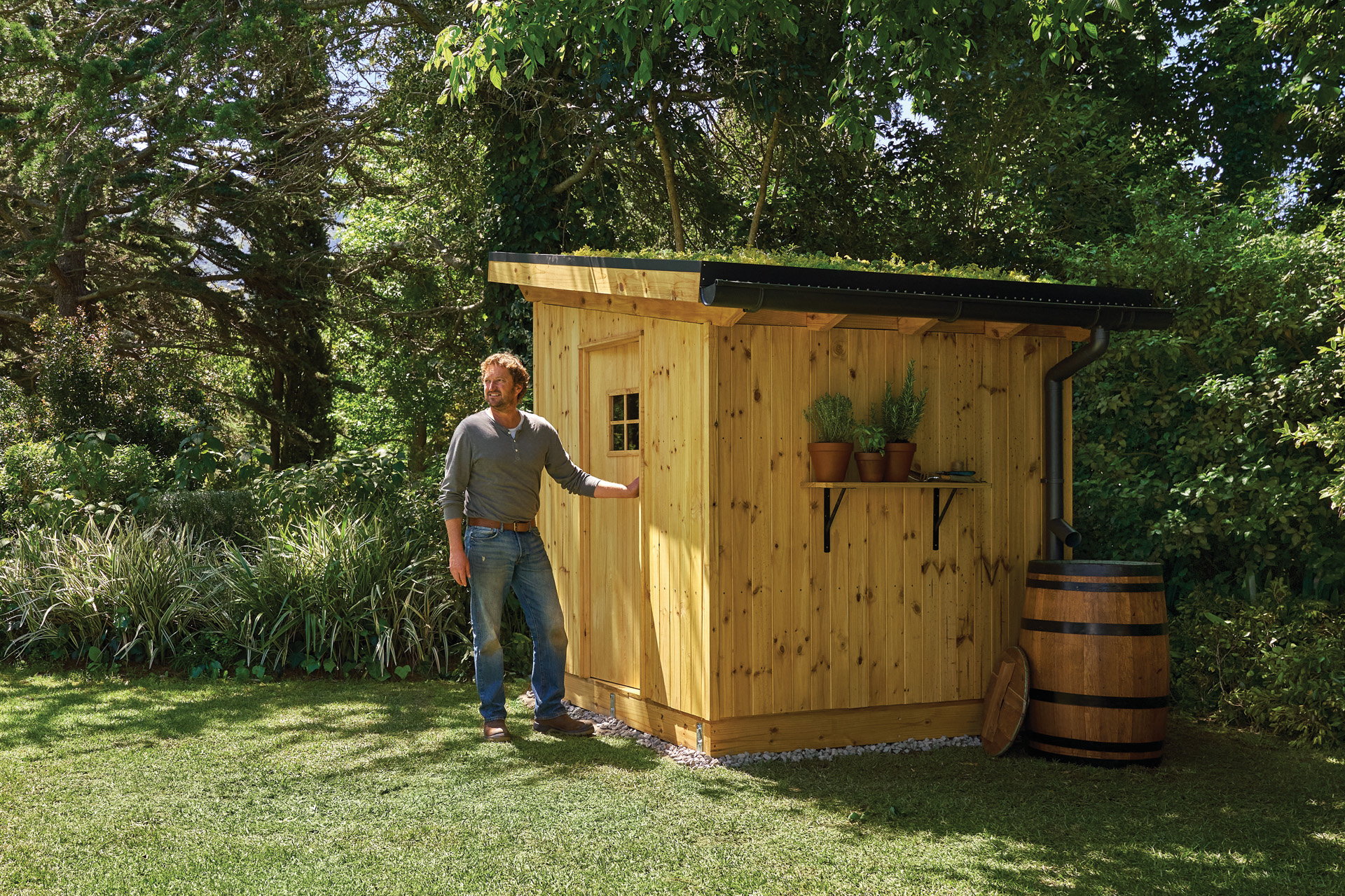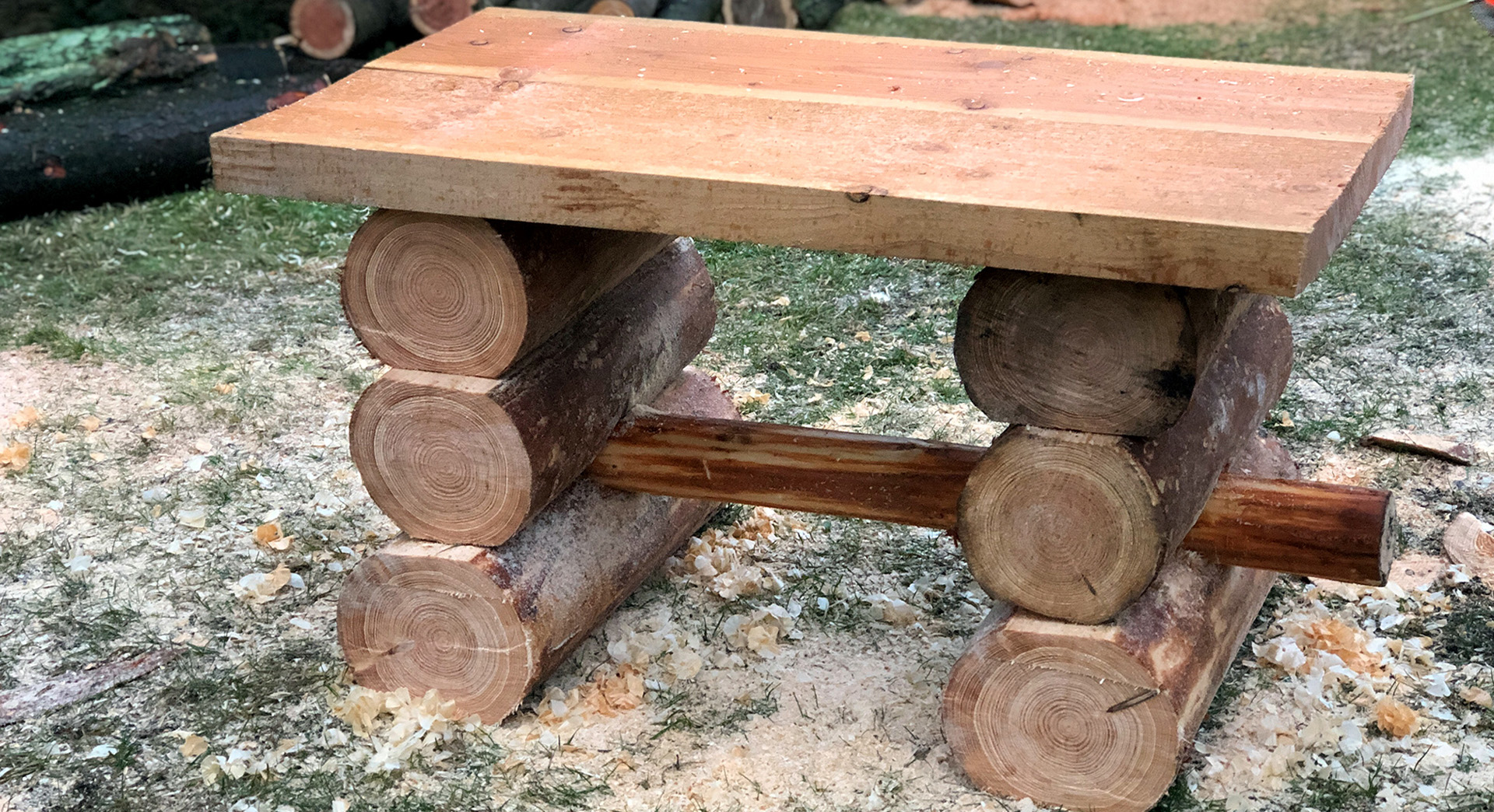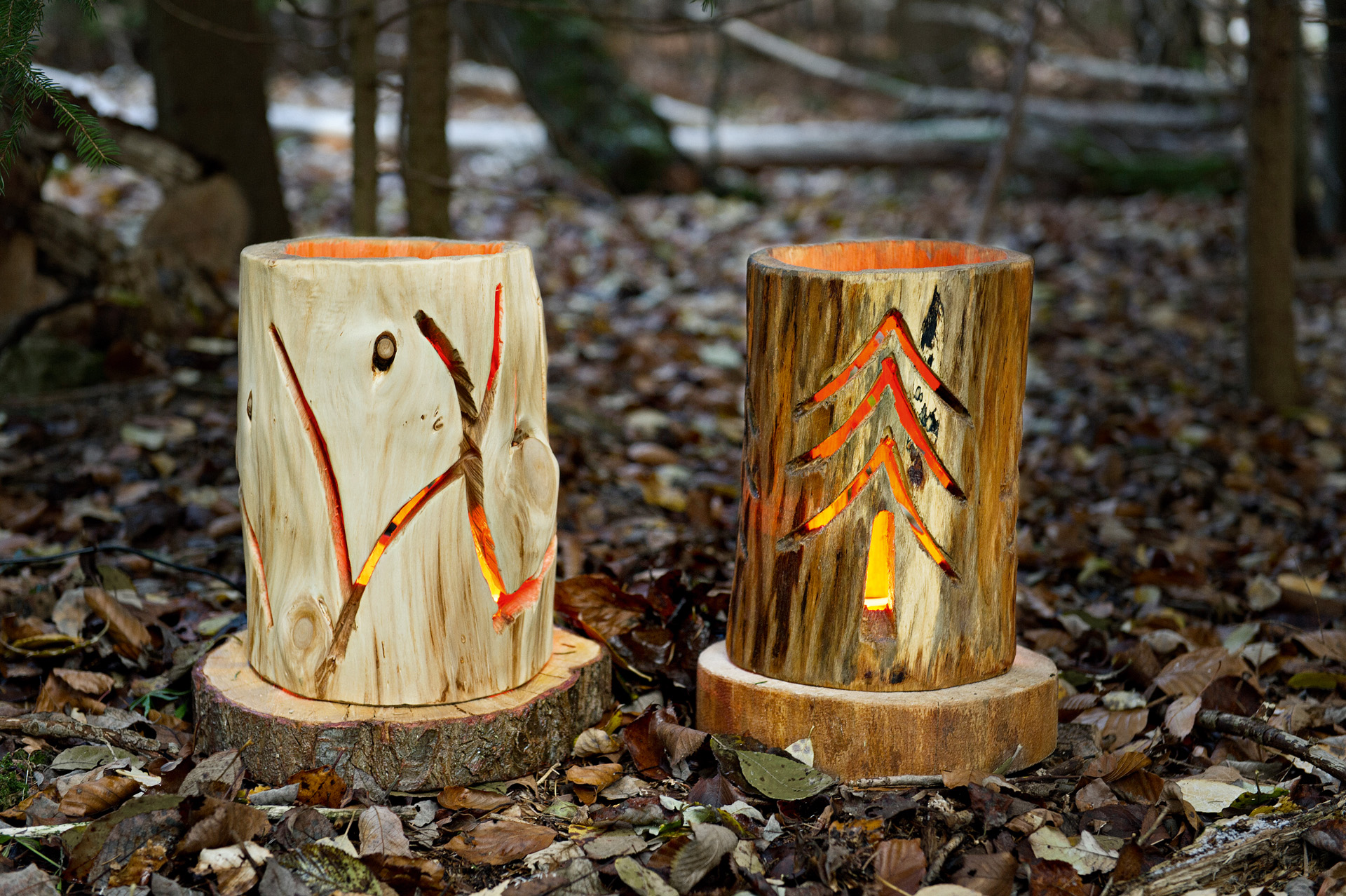DIY guide: how to build your own log store
Do you want to maintain your own supply of firewood? Build a log store to create a place for storing, stacking and seasoning it.
02.02.2024

Wood-burning for heating: enduring appeal and real advantages
The burning of wood for heating is almost as ancient as mankind itself, and continues to enjoy huge popularity. A wood-burning fire or stove is not only attractive but also has many practical benefits when used for heating. It is considered a carbon-neutral fuel because the combustion process only releases as much carbon dioxide as the tree absorbed in its lifetime. Against a background of rising energy prices, firewood may also prove to be an attractive alternative to fuels like gas or domestic heating oil.
If you cut your own firewood, this is a cost-effective option, but remember that proper storage is important even if you buy ready-cut logs. Only properly dried, seasoned wood burns efficiently with minimal air pollution. UK regulations state that the residual moisture content of wood must be at 20% or less for burning, and it will soon only be possible to buy “wet” wood in volumes of 2 m3 or more. Freshly harvested wood needs seasoning for around two years before it's ready to burn. Don’t store logs for more than about 5 years; otherwise, they will start to lose their heating value.
Proper storage must allow the wood to dry out: cellars or sheds are not recommended due to poor air circulation. An open-air shelter offers optimum conditions, so why not build your own log store in the garden for a DIY challenge that will be useful for many years to come?
Our instructions tell you how to use the right equipment to build your own log store. Expect this build to take around 1-2 days. September is a good time to do this project, as it means your log store will be ready in time for an October timber harvest (or delivery). We will also explain the right way to stack your firewood for seasoning.

How to build a log store: the right planning
You will need to consider several things before building your log store. What is the best location for it? Do you need planning permission? Planning and preparation will make sure your log store is successful and useful.
The right location to position your log store
For your log store to work as intended, there are a few things to consider when choosing a location. The prevailing wind in the UK is normally from the west, which means the open side of your log store should ideally face south to protect it from rain, wind and snow. This is particularly important if you want to build a log store without a back wall.
A spot on the south side of the house is ideal, as this is where there will be maximum warmth from the sun to draw moisture from the wood. If you choose to build your log store against a wall or fence, we recommend leaving a gap of at least 10 cm for sufficient air circulation – and remember that the roof should slope forward instead of back so that rain can run off the front of the log store.
STIHL tip: Make life easier for yourself by checking that you can easily take a trolley or wheelbarrow from the site of your log store to your house.
Do you need planning permission for your log store?
Most log stores will fall under permitted development rules in the UK, meaning planning permission is not needed – but you should be sure your plans meet the criteria before you start to build. Height restrictions vary slightly depending on where the store is located, but an outdoor construction with a maximum height of 2.5 metres will not usually be a problem.
There are a few intricacies to planning laws dependent on your exact situation, so you should look over the current building regulations before you start to build your log store.

How to build a log store: preparation
An ambitious project such as a DIY log store requires the right preparation. Along with suitable protective clothing, you should set out the materials and tools you need to build the log store.
Working with powerful tools is fun and means you can broaden your skills, which is great as long as you are relying on effective and safe protective clothing while using them. Always wear your personal protective equipment when working with your chainsaw. This includes a helmet, cut protection trousers, safety boots, and more. More details are available in the instruction manual for your product. Before using your chainsaw for the first time, fully familiarise yourself with the power tool and ensure it is in flawless condition before each use. On request, your STIHL dealer will be happy to prepare your power tool for its first job, and will also advise you on models and sizes of protective clothing that you can try on at your leisure. Please remember that personal protective equipment is no substitute for safe working techniques.

Materials and tools
To build a log store, you will need the following materials and tools.
Note: If your DIY store does not have timber in the exact sizes listed below, go for a larger size instead but never a smaller one.
Materials:
6 pre-cast concrete decking blocks with recess for 50 mm beams
Wood for the foundation (spruce), 3 m of 100 x 50 mm
Construction timber (spruce/pine), 23 m of 76 x 50 mm
Wooden laths, 51 metres of 69 x 22 mm
Square wooden lengths, 7.5 metres of 22 x 22 mm
Corrugated metal sheet, 2200 x 1300 mm (plus necessary screws, washers, and spacers)
Countersunk chipboard screws 4.5 x 50 mm, 3.5 x 40 mm and 6 x 100 mm
Crushed stone chippings
Gravel
If you want to pour concrete pile foundations instead of decking blocks: 6 angle brackets 7 x 7 x 5 cm with rib reinforcement, and 12 concrete anchor bolts with screws
Tools:
- Garden pruner, e.g. STIHL GTA 26 cordless garden pruner
- Chainsaw, e.g. STIHL MSA 70 cordless chainsaw
Cordless screwdriver
Hammer
Carpenters square
Spade
Manual screwdriver
Drill
Tape measure
Pencil
Spirit level
Workbench
How to build a log store: step-by-step instructions
With all your tools assembled, you’re ready to get started with our clear guide.
Note: if your log store stands on a paved or concrete surface, you can skip steps 1 to 3.
STIHL tip: To protect your log store against various environmental stresses, we recommend using pre-treated timber.

Step 1: prepare the ground

Step 2: lay foundations
Compact the earth at the bottom of the holes you have dug and then add 20 cm of gravel to each hole, followed by 10 cm of crushed stone chippings. Set the decking blocks into the holes so they do not protrude more than 1 cm from the ground. Fill any gaps around the blocks with gravel and chippings.

Step 3: lay base joists
Because it’s so important that the wood in your store doesn’t draw moisture from the ground, you need to build a frame that maintains a gap between your stacked firewood and the floor. Use your chainsaw to cut three 1-metre beams from the 50 x 100 mm timber and slot them into the decking blocks.
STIHL professional tip: If you use concrete blocks without grooves, you can fasten the joists to concrete using angle brackets. You will need a suitable concrete drill bit to do this.

Step 4: build floor frame
Using a garden pruner such as the STIHL GTA 26 cordless garden pruner, cut the 76 x 50 construction timber to the following lengths:
2x 1000 mm
3x 1900 mm
Build a rectangular frame with the three long pieces running between shorter lengths. Use butt joints where the pieces meet at a 90° angle, and insert a screw at an angle which is slightly less than 90° – this is always easier if you pre-drill the screw holes. In situations where a butt joint does not work, such as on the roof frame crossbeam, later on, you can screw through both pieces of wood at a 45° angle.
Lay the completed frame onto the base joists and secure it in place using 6 x 100 mm screws.

Step 5: install uprights
Using a chainsaw, cut 76 x 50 mm construction timber to the following lengths:
- 2 x 1350 mm for the front uprights, cut to an 8° angle at the top
- 2 x 1225 mm for the rear uprights, cut to an 8° angle at the top
Now fit the uprights to the inside corners of the floor frame, screwing them in place.

Step 6: add floor
Next, you need to create a plank floor to stack the logs on. Cut 23 1-metre lengths from the 69 x 22 mm laths, and screw them to the wood frame, spaced out evenly across the whole log store. For the outermost laths, remember to cut notches to fit around the uprights.

Step 7: make side walls
The side walls are made from the same laths as the floor. For each wall, cut 8 laths to around 740 mm so that they fit comfortably between the uprights. To do this, cut the 22 x 22 mm square timbers to lengths of 1300 mm for the front and 1200 mm for the rear frame. Space the laths out at intervals of around 6.5 cm and use 4.5 x 50 mm screws to fix them to the square timbers. Attach the finished wall panels to the uprights.

Step 8: construct back wall
We recommend that your log store has a back wall, but you may choose to skip this. The back wall is made in the same way as the side walls.
First cut 8 laths to 1780 mm, so they fit comfortably between the uprights. Space the laths out at intervals of around 6.5 cm and use 4.5 x 50 mm screws to fix them to 1200 mm lengths of 22 x 22 square timber. Fit this panel in place on the back.
Now cut another 69 x 22 timber to 1225 mm, and use 3.5 x 40 mm screws to join it to the back wall as a reinforcing centre upright.

Step 9: build roof
Take the 76 x 50 mm construction timber and cut the roof bars and cross struts to length using the saw. The side boards must be adjusted to the angle of the roof pitch:
- 2x 1900 mm
- 1x 900 mm
- 2x 1000 mm
- 2x 925 mm
Then attach the roof frame to the supporting posts and secure the cross struts.

Step 10: make roof
Use the garden pruner to cut two 400 mm support braces from the 76 x 50 mm timber so they fit at 45°, and attach them both to the front. You can now fix the corrugated sheet onto the beams from above.
Finished! Your log store is ready to fill with wood.
Maintaining your log store
If you use pre-treated wood to build your log store, it will need minimal maintenance. Just brush leaves off the roof in autumn and remove any moss in spring.
How to stack and store firewood
With your log store built, you’re nearly ready to go – but you still need to stack the wood correctly so that air circulates properly around it; otherwise, it will not reach the necessary residual moisture content level of 20%. With good stacking, this should be achievable in around 2 years, though hardwood needs longer to season than softwood. Hardwood is also less affected by the weather.
STIHL professional tip: Moisture gauges can be used to quickly detect whether your firewood is dry enough to burn efficiently and cleanly.
You should ideally start by laying a few split logs across the front of the log store so that wood doesn’t slide out of the front as you are stacking it. Then you can start loosely stacking your firewood. As a natural product that has been cut by hand, you can expect the pieces to all be different sizes and not to stack together tightly: this is good, as small gaps throughout the stack provide adequate air circulation to help the wood to season. Always make sure that your firewood is not in contact with the ground or with branches and twigs.

Summary: how to build a log store
Though planning permission is not usually required for a garden log store, check the regulations before you start to build.
Choose a suitable location. South-facing can make efficient use of heat from the sun.
If you want to put your log store against a wall, leave a gap of around 10 cm and make sure your roof slants down towards the front.
The open side of the store should ideally face south/south-east to better protect your firewood from the elements.
When working, always wear personal protective equipment according to the instruction manual for your power tool.
Gather up all the materials and tools you need first, and follow the instructions in our guide.
Firewood must be sufficiently dry before use. The maximum residual moisture content is set by law at 20%.
Freshly harvested firewood needs to be stored for around two years before you can burn it.
To guarantee adequate air circulation, stack your firewood up loosely. You can place a few split logs across the front of your log store to prevent wood from sliding out of the front.





/catalogue/stihl-catalogue-2019-(master)/cutting-attachments/6250c0016350403c865730b8d47596d9.jpg)

